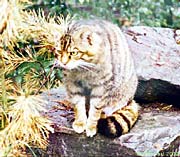Some of the wild cat populations in Europe may become extinct due to inter-racial "assimilation".

By David Ref
A wild cat in Scotland. Seven out of eight are actually hybrid creatures
Photo: from gro.stacgib.www//:ptth
Racial purity is an assigned concept, contrary to the spirit of political correctness that has been blowing in Europe in recent years. But when it comes to wild cats, most researchers are united in the opinion that inter-racial assimilation is a terrible and terrible thing.
A study published about a year ago in the journal "Molecular Ecology" provides scientific data, with the help of which biologists can deal with the constant fear that if nothing is done to prevent the domesticated cats from mating with the wild cats throughout Europe - they will disappear from the face of the earth. It turns out that this expectation is not true for all wild cat populations in Europe.
The wildcat species is divided into three subspecies, based on their geographic location: the European, African and Asian wildcat. Another species, which split several thousand years ago from the wild cat, is the domesticated cat.
Today, both European wild cats and African wild cats are found throughout Europe - as well as domesticated cats in large numbers. Mating with domesticated cats depletes the "pure" genetic pool of wild cats. In the study in question, 336 cats were examined, in 12 specified sites, in the territory of nine European countries. They were divided into groups, according to the following breakdown: 130 domestic cats, 165 European wild cats, 16 African wild cats and 25 cats defined as "mixed".
The researchers examined the external appearance of the cats, but also genetic characteristics. The results show significant differences in the ratio between the domestic wild cats in the wild cat populations in different regions of Europe.
In Scotland much mixing is found. According to estimates by various definitions of wild animals, only one out of eight wild cats in Scotland is indeed an authentic wild cat - that is, pure. The remaining seven are hybrid creatures - hybrids of stray cats and feral cats.
But the research shows that there are also places that are a kind of ethnic pockets - areas where the wild cat population hardly mixed with domesticated cats (nor with other populations of wild cats). One of the places where this phenomenon was discovered is northern Germany. The explanation offered by the authors of the article for the phenomenon concerns, it turns out, the extermination efforts made by the authorities in the region in the 19th century. It was then decided to eliminate the wild cats, and the few surviving individuals, in isolated areas, are responsible for the redevelopment of the small population. Hence the little diversity in genetic diversity in such groups.
The authors of the article point out that in most of the territory of Central and Southern Europe, the wild cat populations are separated from the domesticated cats; In some areas, such as Hungary, many hybrid offspring appear, in a variety of physical and genetic manifestations - the result of many years of mating between the species.

2 תגובות
Domesticated is the female of domesticated.
The words "domesticated" and "domesticated" (as well as "domesticated" which is a reversal of domesticated/domesticated) are derived from the word "house" and mean - adaptation to life in or near a home - in partnership with humans.
The reference is to the adaptation carried out at the initiative of humans or at least with their consent and not to a parasitic adaptation such as that undergone by certain insects and rodents.
What is domesticated?